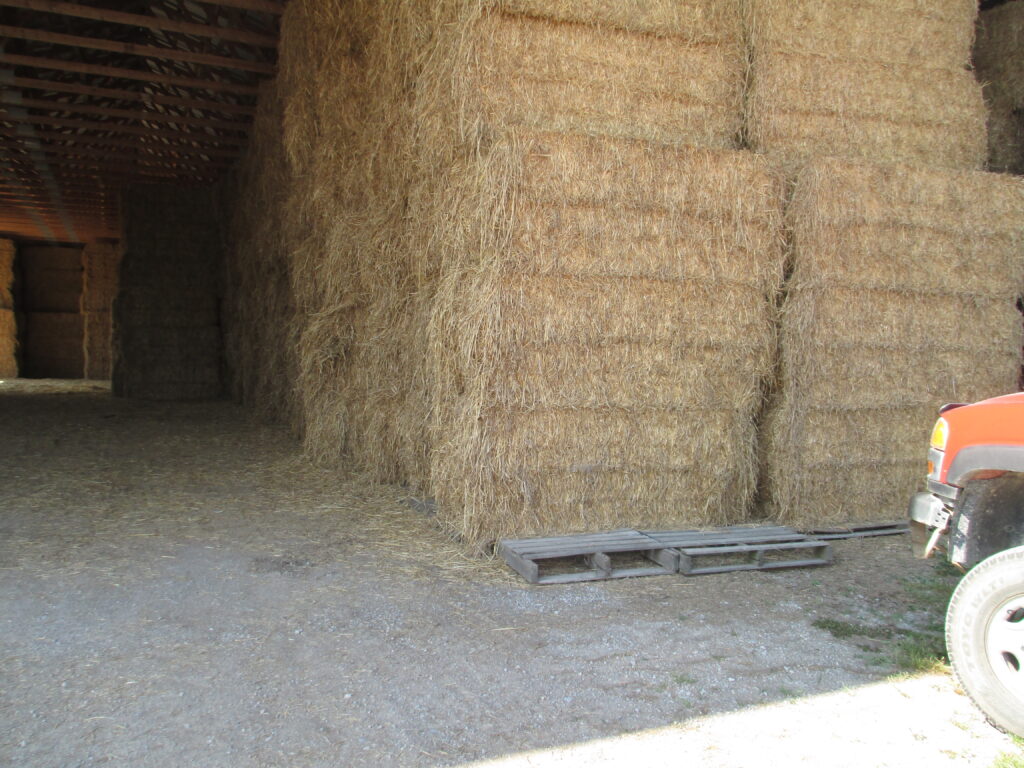Storing hay outside and exposed can cause large losses due to spoilage, often up to 61%. While precipitation usually takes the blame for spoiled hay, the bales also wick moisture up from the ground.
Storing hay under a roof will minimize spoilage. Typical storage losses under a roof are 2%–10%. While an initial capital expense, building long-term inside hay storage can be one of the best on-farm investments. When storing hay inside, make sure the hay is dry. Concrete floors will “sweat” when warm air and cool concrete cause condensation, and this moisture can be drawn up into hay bales. A gravel or asphalt floor can reduce sweating to hay on the bottom versus hay stored on a cement floor.
Pallets have been used successfully to raise bales off a cement floor to prevent the hay from wicking up moisture. Hay should be at least 60 cm (24 in.) away from the roof to promote air flow. If the hay shed has walls, it is recommended to leave at least a 50-cm (20-in.) gap between the wall and the hay. This space prevents the bales from wicking condensation from the walls and allows air flow around the stack. This space also keeps the hay from leaning against the shed walls, which are generally not designed to support the extra weight of hay bales. A larger space can be left to enable checking the hay for heat.

Figure 1. Hay that has been wrapped shows little spoilage
If a shed is not available, the next best option to reduce spoilage is to wrap the dry hay (Figure 1). Wrapping or using a bale sleeve typically results in 4%–8% dry matter losses during storage. Some producers use one to two wraps, while others use up to six layers, similar to haylage.
If the wrapped hay is damp, there may still be spoilage on the outside of the bales. Even wrapping with more plastic will not stop spoilage of damp hay.
Covering bales with tarps can reduce spoilage. Losses in tarped hay stored on the ground range from 4%–46%. A well-drained base reduces the odds of the bottom row sitting in pooled water — losses are generally 2%–17% when the storage site drains well. Keeping the tarps on through the winds of winter is a challenge. Make sure the tarps are secured well, so the wind does not shred them. Some producers tie down the tarps to the bales themselves. Others use tires or sandbags to secure the tarps. Feeding bales from a tarped stack can be more time-consuming as the tarp will need to be rolled back as you feed the bales out.
Square bales must be covered to prevent significant amounts of spoilage, however, because of their shape, round bales have some ability to shed precipitation. Round bales should not be stored on their flat ends, as they lose the ability to shed water and have a greater surface area touching the ground to wick up moisture.
If bales must be stored outside, remember that net-wrapped bales tend to be wound tighter and held together more firmly than twine-wrapped bales (Figure 2). Net-wrapped bales shed rain more effectively with less spoilage. University of Wisconsin researchers measured moisture levels in the outside hay rind of net-wrapped alfalfa bales and twine-wrapped bales. They found that net-wrapped alfalfa bales shed rainfall better than twine-wrapped bales. Nutrient composition was significantly higher in the outside hay rind and losses were lower for bales wrapped with net wrap compared to bales wrapped with twine. The core of the bale was generally unaffected by wrap type. Average overall total dry matter losses were 11.3% and 7.3% for plastic twine-wrapped bales and net-wrapped bales, respectively. It is important to consider that, in either situation, bales that are not stored on a well-drained surface can absorb moisture at the bottom of the bales.

Figure 2.Net wrapped bales shed water better than twine wrapped bales and are better suited to outdoor storage
Another method to reduce spoilage is to leave space between bales as they are stored (Figure 3). This means the rainwater does not collect between the bales, reducing spoilage.

Figure 3. Leaving a gap between bales stored outside prevents moisture being trapped between bales
When hay is stored outside, it is important to have a dry base for the bales (Table 1). Having a gravel base lets rainwater drain away, rather than collect into the bottom of the bales.
Table 1. Hay loss associated with various storage methods

